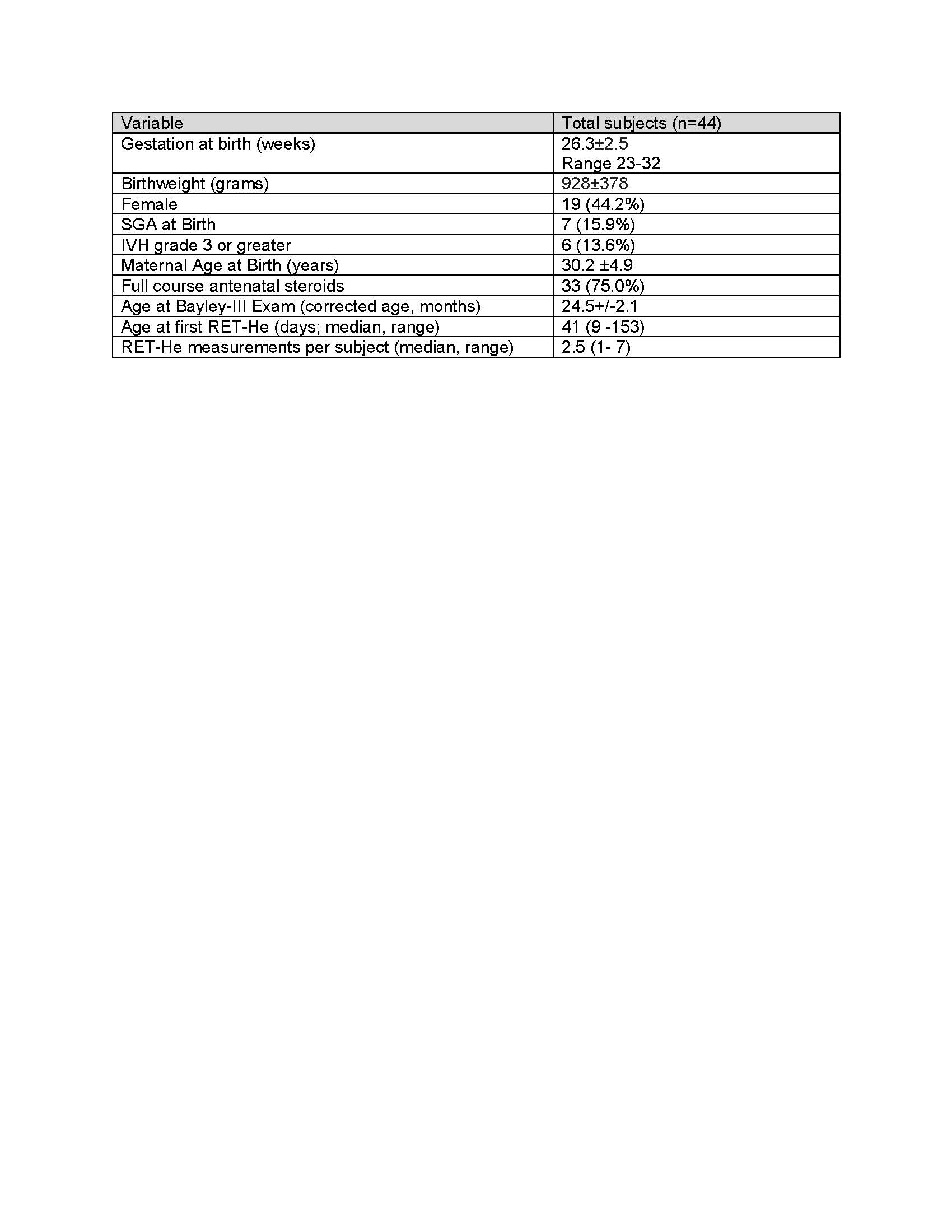Neonatal Follow-up
Category: Abstract Submission
Neonatal Follow-up II
254 - Iron Supplementation in Preterm Infants associated with 2 Year Bayley-III Cognitive Outcomes
Saturday, April 23, 2022
3:30 PM - 6:00 PM US MT
Poster Number: 254
Publication Number: 254.224
Publication Number: 254.224
Whitley N. Hulse, University of Utah, Salt Lake City, UT, United States; Timothy M. Bahr, Intermountain Healthcare, Salt Lake City, UT, United States; Robin K. Ohls, University of Utah, Salt Lake City, UT, United States; Tara L. DuPont, University of Utah, salt lake city, UT, United States

Whitley N. Hulse, MD
Fellow
University of Utah
University of Utah Health
Salt Lake City, Utah, United States
Presenting Author(s)
Background: Iron deficiency has previously been associated with neurocognitive impairments in infants. Reticulocyte hemoglobin level (RET-He) is a quantification of the hemoglobin in reticulocytes which provides information about the iron stores available for hemoglobin synthesis. It is unknown whether iron status, evaluated by iron supplementation or RET-He, is associated with cognitive outcomes of preterm infants
Objective: To determine whether there is an association between iron supplementation or RET-He level in preterm infants and Bayley Scales of Infant and Toddler Development 3rd edition (Bayley-III) cognitive composite scores at two years of life.
Design/Methods: Retrospective chart review of infants who completed neonatal follow-up through the University of Utah Developmental Assessment Center. Eligible infants included those born ≤ 26 weeks gestational age or born ≤ 1250 g. Infants were born at 5 level III NICUs in Utah and were included in the analysis if they had completed the Bayley-III, and had a least one RET-He measured during their initial hospitalization. We used multiple linear regression to evaluate whether RET-He or mean daily iron dose were associated with Bayley-III scores. All statistical analyses were done in the R language and environment for statistical computing.
Results: Forty-four neonates (26.3±2.5 weeks gestation, 928±378 grams birthweight) born between 2014-2018 were included in the analysis. Developmental testing occurred at 24.5±2.1 months corrected age. After adjusting for birth weight, the severity of intraventricular hemorrhage, and antenatal steroid administration, there was a statistically significant association between mean total daily iron dose (mg/kg/d) and the Bayley-III cognitive composite score (p=0.017) (Figure 1), as well as between the change between the maximum and minimum RET-He and the Bayley-III cognitive composite score (p=0.014) (Figure 2). There was no statistically significant association between maximum or minimum RET-He and Bayley-III cognitive composite score (p=0.43) (Figures 3-4). Conclusion(s): Our results suggest a positive association between the mean total daily iron dose and the change of RET-He level with cognitive outcomes at 2 years of age. Though, there was no association between maximum or minimum RET-He and cognitive score. Further studies are needed to investigate the effect of iron supplementation on cognitive outcomes of preterm infants and optimal methods to monitor adequate supplementation.
Table 1 Demographics
Demographics
Figure 1.jpg) Mean total daily supplemental iron dosing (mg/kg/d) compared to Bayley-III Cognitive Composite score after adjusting for birth weight, the severity of intraventricular hemorrhage, and antenatal steroid administration
Mean total daily supplemental iron dosing (mg/kg/d) compared to Bayley-III Cognitive Composite score after adjusting for birth weight, the severity of intraventricular hemorrhage, and antenatal steroid administration
Objective: To determine whether there is an association between iron supplementation or RET-He level in preterm infants and Bayley Scales of Infant and Toddler Development 3rd edition (Bayley-III) cognitive composite scores at two years of life.
Design/Methods: Retrospective chart review of infants who completed neonatal follow-up through the University of Utah Developmental Assessment Center. Eligible infants included those born ≤ 26 weeks gestational age or born ≤ 1250 g. Infants were born at 5 level III NICUs in Utah and were included in the analysis if they had completed the Bayley-III, and had a least one RET-He measured during their initial hospitalization. We used multiple linear regression to evaluate whether RET-He or mean daily iron dose were associated with Bayley-III scores. All statistical analyses were done in the R language and environment for statistical computing.
Results: Forty-four neonates (26.3±2.5 weeks gestation, 928±378 grams birthweight) born between 2014-2018 were included in the analysis. Developmental testing occurred at 24.5±2.1 months corrected age. After adjusting for birth weight, the severity of intraventricular hemorrhage, and antenatal steroid administration, there was a statistically significant association between mean total daily iron dose (mg/kg/d) and the Bayley-III cognitive composite score (p=0.017) (Figure 1), as well as between the change between the maximum and minimum RET-He and the Bayley-III cognitive composite score (p=0.014) (Figure 2). There was no statistically significant association between maximum or minimum RET-He and Bayley-III cognitive composite score (p=0.43) (Figures 3-4). Conclusion(s): Our results suggest a positive association between the mean total daily iron dose and the change of RET-He level with cognitive outcomes at 2 years of age. Though, there was no association between maximum or minimum RET-He and cognitive score. Further studies are needed to investigate the effect of iron supplementation on cognitive outcomes of preterm infants and optimal methods to monitor adequate supplementation.
Table 1
 Demographics
DemographicsFigure 1
.jpg) Mean total daily supplemental iron dosing (mg/kg/d) compared to Bayley-III Cognitive Composite score after adjusting for birth weight, the severity of intraventricular hemorrhage, and antenatal steroid administration
Mean total daily supplemental iron dosing (mg/kg/d) compared to Bayley-III Cognitive Composite score after adjusting for birth weight, the severity of intraventricular hemorrhage, and antenatal steroid administration